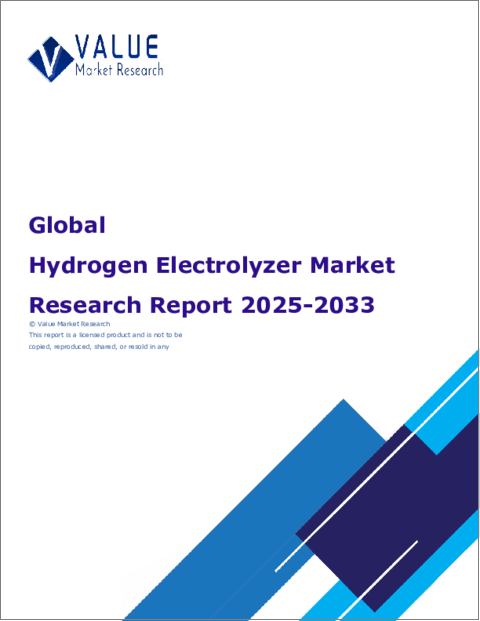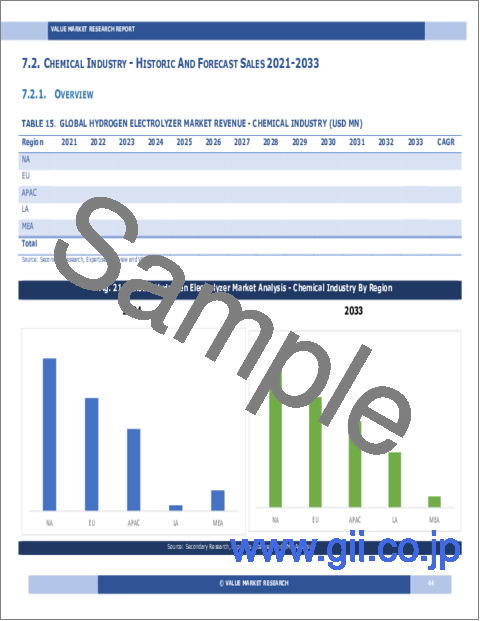|
|
市場調査レポート
商品コード
1721241
水素電解槽の世界市場調査レポート:産業分析、規模、シェア、成長、動向、2025年から2033年までの予測Global Hydrogen Electrolyzer Market Research Report- Industry Analysis, Size, Share, Growth, Trends and Forecast 2025 to 2033 |
||||||
カスタマイズ可能
|
|||||||
| 水素電解槽の世界市場調査レポート:産業分析、規模、シェア、成長、動向、2025年から2033年までの予測 |
|
出版日: 2025年04月01日
発行: Value Market Research
ページ情報: 英文 130 Pages
納期: 即日から翌営業日
|
全表示
- 概要
- 図表
- 目次
水素電解槽の世界市場規模は、2024年の7億6,913万米ドルから2033年には64億8,505万米ドルに成長し、2026年から2033年の予測期間中に26.73%の堅調な年間平均成長率(CAGR)を示すと予測されます。
水素電解槽市場は、世界のエネルギー事情がよりクリーンで持続可能な代替エネルギーへとシフトする中で、大きく拡大する瀬戸際にあります。ゼロ・エミッション燃料としての可能性が認められている水素は、輸送、工業プロセス、エネルギー貯蔵を含む様々な用途で支持を集めています。水の電気分解による水素製造を促進する電解槽は、水素経済への移行においてますます不可欠になっています。政府や産業界が脱炭素化への取り組みを優先する中、効率的で費用対効果の高い水素電解槽への需要が急増し、この重要な分野への技術革新と投資が促進されると予想されます。
さらに、電解槽技術の進歩が水素製造の効率と拡張性を高めています。新しい材料と設計の開発は、より高いエネルギー変換率と低い運転コストにつながり、水素製造をより経済的に実行可能なものにしています。産業界が水素をエネルギー・システムに組み込もうとするにつれ、大規模運転が可能な先進的電解槽への需要が高まり、メーカーや技術プロバイダーに新たな機会が生まれる可能性が高いです。さらに、利害関係者が持続可能な水素製造方法の重要性を認識しているため、再生可能エネルギー源を使用して製造されるグリーン水素への関心が高まっており、市場の成長をさらに後押ししています。
エネルギー転換と持続可能性への世界の注目が高まる中、水素電解槽市場はエネルギーの未来を形作る上で極めて重要な役割を果たす立場にあります。水素インフラへの投資が増加し、支援的な規制枠組みが開発されることで、市場プレーヤーにとって有利な環境が整うと思われます。この市場の将来は、技術革新、協調、そして急速に変化する世界の進化するエネルギー需要への対応へのコミットメントによって特徴付けられ、水素電解槽がクリーンエネルギー革命の最前線に位置し続けることを確実にします。
当社のレポートは、様々な産業や市場に関する包括的かつ実用的な洞察をお客様に提供するために、細心の注意を払って作成されています。各レポートは、市場情勢を完全に理解するために、いくつかの重要な要素を含んでいます:
市場概要:市場概要:定義、分類、業界の現状など、市場に関する詳細なイントロダクション。
市場促進要因:市場成長に影響を与える主な促進要因・抑制要因・市場促進要因・課題を詳細に分析します。このセクションでは、技術の進歩、規制の変更、新たな動向などの要因を検証します。
セグメンテーション分析:製品タイプ、用途、最終用途、地域などの基準に基づき、市場を明確なセグメントに内訳。この分析により、各セグメントの業績と将来性を明らかにします。
競合情勢:市場シェア、製品ポートフォリオ、戦略的イニシアティブ、財務実績など、主要市場プレイヤーの包括的評価。主要企業が採用する競合力学と主要戦略に関する考察を提供します。
市場予測:過去のデータと現在の市場状況に基づき、一定期間における市場規模と成長動向を予測します。これには、定量的分析と将来の市場軌跡を示すグラフ表示が含まれます。
地域分析:地域ごとの市場パフォーマンスを評価し、主要市場や地域動向を明らかにします。地域の市場力学とビジネスチャンスを理解するのに役立ちます。
新たな動向と機会:現在の市場動向と新たな市場動向、技術革新、潜在的な投資対象分野を特定します。将来の市場開拓と成長見通しに関する洞察を提供します。
目次
第1章 序文
第2章 エグゼクティブサマリー
- 市場のハイライト
- 世界市場スナップショット
第3章 水素電解槽産業分析
- イントロダクション:市場力学
- 市場促進要因
- 市場抑制要因
- 市場機会
- 業界動向
- ファイブフォース分析
- 市場の魅力分析
第4章 バリューチェーン分析
- バリューチェーン分析
- 原材料分析
- 原材料リスト
- 原材料メーカーリスト
- 主要原材料の価格動向
- 潜在的バイヤーリスト
- マーケティングチャネル
- ダイレクトマーケティング
- インダイレクトマーケティング
- マーケティングチャネル発展動向
第5章 水素電解槽の世界市場分析:技術別
- 技術別の概要
- 技術別の過去および予測データ分析
- プロトン交換膜(PEM)電解槽
- アルカリ電解槽(AE)
- 固体酸化物電解槽(SOE)
- 陰イオン交換膜電解槽
第6章 水素電解槽の世界市場分析:発電容量別
- 発電容量別の概要
- 発電容量別の過去および予測データ分析
- <500 kW売上実績と予測分析地域別
- 500 kWー2,000 kW
- 2,000 kW
第7章 水素電解槽の世界市場分析:最終用途産業別
- 最終用途産業別の概要
- 最終用途産業別の過去および予測データ分析
- 化学産業
- 精製
- 発電
- その他
第8章 水素電解槽の世界市場分析:地域別
- 地域別展望
- イントロダクション
- 北米売上分析
- 概要、実績と予測
- 北米セグメント別
- 北米国別
- 米国
- カナダ
- メキシコ
- 欧州売上分析
- 概要、実績と予測
- 欧州セグメント別
- 欧州国別
- 英国
- フランス
- ドイツ
- イタリア
- ロシア
- その他欧州
- アジア太平洋地域売上分析
- 概要、実績と予測
- アジア太平洋地域セグメント別
- アジア太平洋地域国別
- 中国
- インド
- 日本
- 韓国
- オーストラリア
- 東南アジア
- その他アジア太平洋地域
- ラテンアメリカ売上分析
- 概要、実績と予測
- ラテンアメリカセグメント別
- ラテンアメリカ国別
- ブラジル
- アルゼンチン
- ペルー
- チリ
- その他ラテンアメリカ
- 中東・アフリカ売上分析
- 概要、実績と予測
- 中東・アフリカセグメント別
- 中東・アフリカ国別一覧
- サウジアラビア
- アラブ首長国連邦
- イスラエル
- 南アフリカ
- その他中東とアフリカ
第9章 水素電解槽メーカーの競合情勢
- 水素電解槽市場の競合
- 提携・協力・合意
- 合併・買収
- 新製品の発売
- その他の開発
第10章 企業プロファイル
- 上位企業の市場シェア分析
- 市場集中度
- Nel ASA
- Siemens Energy
- ITM Power
- Plug Power Inc.
- Cummins Inc.
- McPhy Energy
- Ballard Power Systems
- Toshiba Energy Systems & Solutions Corporation
- Green Hydrogen Systems
- Enapter
LIST OF TABLES
- Market Snapshot
- Drivers: Impact Analysis
- Restraints: Impact Analysis
- List of Raw Material
- List of Raw Material Manufactures
- Analysis By Technology (USD MN)
- Proton Exchange Membrane (PEM) Electrolyzer Market Sales By Geography (USD MN)
- Alkaline Electrolyzer (AE) Market Sales By Geography (USD MN)
- Solid Oxide Electrolyzer (SOE) Market Sales By Geography (USD MN)
- Anion Exchange Membrane Electrolyzer Market Sales By Geography (USD MN)
- Analysis By Power Generation Capacity (USD MN)
- <500 kW Market Sales By Geography (USD MN)
- 500a€"2,000 kW Market Sales By Geography (USD MN)
- 2,000 kW Market Sales By Geography (USD MN)
- Analysis By End-use Industry (USD MN)
- Chemical Industry Market Sales By Geography (USD MN)
- Refining Market Sales By Geography (USD MN)
- Power Generation Market Sales By Geography (USD MN)
- Others Market Sales By Geography (USD MN)
- Global Hydrogen Electrolyzer Market Sales By Geography (USD MN)
- North America Market Analysis (USD MN)
- United States Market Analysis (USD MN)
- Canada Market Analysis (USD MN)
- Mexico Market Analysis (USD MN)
- Europe Market Analysis (USD MN)
- Europe Market Estimate By Country (USD MN)
- United Kingdom Market Analysis (USD MN)
- France Market Analysis (USD MN)
- Germany Market Analysis (USD MN)
- Italy Market Analysis (USD MN)
- Russia Market Analysis (USD MN)
- Spain Market Analysis (USD MN)
- Rest of Europe Market Analysis (USD MN)
- Asia Pacific Market Analysis (USD MN)
- China Market Analysis (USD MN)
- Japan Market Analysis (USD MN)
- India Market Analysis (USD MN)
- South Korea Market Analysis (USD MN)
- Australia Market Analysis (USD MN)
- South East Asia Market Analysis (USD MN)
- Rest of Asia Pacific Market Analysis (USD MN)
- Latin America Market Analysis (USD MN)
- Brazil Market Analysis (USD MN)
- Argentina Market Analysis (USD MN)
- Peru Market Analysis (USD MN)
- Chile Market Analysis (USD MN)
- Rest of Latin America Market Analysis (USD MN)
- Middle East & Africa Market Analysis (USD MN)
- Saudi Arabia Market Analysis (USD MN)
- UAE Market Analysis (USD MN)
- Israel Market Analysis (USD MN)
- South Africa Market Analysis (USD MN)
- Rest of Middle East and Africa Market Analysis (USD MN)
- Partnership/Collaboration/Agreement
- Mergers And Acquisition
LIST OF FIGURES
- Research Scope of Hydrogen Electrolyzer Report
- Market Research Process
- Market Research Methodology
- Global Hydrogen Electrolyzer Market Size, By Region (USD MN)
- Porters Five Forces Analysis
- Market Attractiveness Analysis By Technology
- Market Attractiveness Analysis By Power Generation Capacity
- Market Attractiveness Analysis By End-use Industry
- Market Attractiveness Analysis By Region
- Value Chain Analysis
- Global Market Analysis By Technology (USD MN)
- Proton Exchange Membrane (PEM) Electrolyzer Market Sales By Geography (USD MN)
- Alkaline Electrolyzer (AE) Market Sales By Geography (USD MN)
- Solid Oxide Electrolyzer (SOE) Market Sales By Geography (USD MN)
- Anion Exchange Membrane Electrolyzer Market Sales By Geography (USD MN)
- Global Market Analysis By Power Generation Capacity (USD MN)
- <500 kW Market Sales By Geography (USD MN)
- 500a€"2,000 kW Market Sales By Geography (USD MN)
- 2,000 kW Market Sales By Geography (USD MN)
- Global Market Analysis By End-use Industry (USD MN)
- Chemical Industry Market Sales By Geography (USD MN)
- Refining Market Sales By Geography (USD MN)
- Power Generation Market Sales By Geography (USD MN)
- Others Market Sales By Geography (USD MN)
- Global Market Sales (USD MN)
- North America Market Sales (USD MN)
- Europe Market Sales (USD MN)
- Asia Pacific Market Sales (USD MN)
- Latin America Market Sales (USD MN)
- Middle East & Africa Market Sales (USD MN)
- Recent Development in Industry
- Top Company Market Share Analysis
Kindly note that the above listed are the basic tables and figures of the report and are not limited to the TOC.
Global Hydrogen Electrolyzer Market size is anticipated to grow from USD 769.13 Million in 2024 to USD 6485.05 Million by 2033, showcasing a robust Compound Annual Growth Rate (CAGR) of 26.73% during the forecast period of 2026 to 2033.
The hydrogen electrolyzer market is on the brink of significant expansion as the global energy landscape shifts towards cleaner and more sustainable alternatives. Hydrogen, recognized for its potential as a zero-emission fuel, is gaining traction in various applications, including transportation, industrial processes, and energy storage. Electrolyzers, which facilitate the production of hydrogen through the electrolysis of water, are becoming increasingly vital in the transition to a hydrogen economy. As governments and industries prioritize decarbonization efforts, the demand for efficient and cost-effective hydrogen electrolyzers is expected to surge, driving innovation and investment in this critical sector.
Moreover, advancements in electrolyzer technology are enhancing the efficiency and scalability of hydrogen production. The development of new materials and designs is leading to higher energy conversion rates and lower operational costs, making hydrogen production more economically viable. As industries seek to integrate hydrogen into their energy systems, the demand for advanced electrolyzers that can operate at scale will likely increase, creating new opportunities for manufacturers and technology providers. Additionally, the growing interest in green hydrogen, produced using renewable energy sources, is further propelling market growth as stakeholders recognize the importance of sustainable hydrogen production methods.
As the global focus on energy transition and sustainability intensifies, the hydrogen electrolyzer market is well-positioned to play a pivotal role in shaping the future of energy. The increasing investment in hydrogen infrastructure and the development of supportive regulatory frameworks will create a favorable environment for market players. The future of this market is characterized by innovation, collaboration, and a commitment to meeting the evolving energy demands of a rapidly changing world, ensuring that hydrogen electrolyzers remain at the forefront of the clean energy revolution.
Our reports are meticulously crafted to provide clients with comprehensive and actionable insights into various industries and markets. Each report encompasses several critical components to ensure a thorough understanding of the market landscape:
Market Overview: A detailed introduction to the market, including definitions, classifications, and an overview of the industry's current state.
Market Dynamics: In-depth analysis of key drivers, restraints, opportunities, and challenges influencing market growth. This section examines factors such as technological advancements, regulatory changes, and emerging trends.
Segmentation Analysis: Breakdown of the market into distinct segments based on criteria like product type, application, end-user, and geography. This analysis highlights the performance and potential of each segment.
Competitive Landscape: Comprehensive assessment of major market players, including their market share, product portfolio, strategic initiatives, and financial performance. This section provides insights into the competitive dynamics and key strategies adopted by leading companies.
Market Forecast: Projections of market size and growth trends over a specified period, based on historical data and current market conditions. This includes quantitative analyses and graphical representations to illustrate future market trajectories.
Regional Analysis: Evaluation of market performance across different geographical regions, identifying key markets and regional trends. This helps in understanding regional market dynamics and opportunities.
Emerging Trends and Opportunities: Identification of current and emerging market trends, technological innovations, and potential areas for investment. This section offers insights into future market developments and growth prospects.
SEGMENTATION COVERED IN THE REPORT
By Technology
- Proton Exchange Membrane (PEM) Electrolyzer
- Alkaline Electrolyzer (AE)
- Solid Oxide Electrolyzer (SOE)
- Anion Exchange Membrane Electrolyzer
By Power Generation Capacity
- <500 kW
- 500-2,000 kW
- 2,000 kW
By End-use Industry
- Chemical Industry
- Refining
- Power Generation
- Others
- COMPANIES PROFILED
- Nel ASA
- Siemens Energy
- ITM Power
- Plug Power Inc.
- Cummins Inc.
- McPhy Energy
- Ballard Power Systems
- Toshiba Energy Systems & Solutions Corporation
- Green Hydrogen Systems
- Enapter
- The above list can be customized.
TABLE OF CONTENTS
1. PREFACE
- 1.1. Report Description
- 1.1.1 Objective
- 1.1.2 Target Audience
- 1.1.3 Unique Selling Proposition (USP) & offerings
- 1.2. Research Scope
- 1.3. Research Methodology
- 1.3.1 Market Research Process
- 1.3.2 Market Research Methodology
2. EXECUTIVE SUMMARY
- 2.1. Highlights of Market
- 2.2. Global Market Snapshot
3. HYDROGEN ELECTROLYZER INDUSTRY ANALYSIS
- 3.1. Introduction - Market Dynamics
- 3.2. Market Drivers
- 3.3. Market Restraints
- 3.4. Opportunities
- 3.5. Industry Trends
- 3.6. Poerter's Five Force Analysis
- 3.7. Market Attractiveness Analysis
- 3.7.1 Market Attractiveness Analysis By Technology
- 3.7.2 Market Attractiveness Analysis By Power Generation Capacity
- 3.7.3 Market Attractiveness Analysis By End-use Industry
- 3.7.4 Market Attractiveness Analysis By Region
4. VALUE CHAIN ANALYSIS
- 4.1. Value Chain Analysis
- 4.2. Raw Material Analysis
- 4.2.1 List of Raw Materials
- 4.2.2 Raw Material Manufactures List
- 4.2.3 Price Trend of Key Raw Materials
- 4.3. List of Potential Buyers
- 4.4. Marketing Channel
- 4.4.1 Direct Marketing
- 4.4.2 Indirect Marketing
- 4.4.3 Marketing Channel Development Trend
5. GLOBAL HYDROGEN ELECTROLYZER MARKET ANALYSIS BY TECHNOLOGY
- 5.1. Overview By Technology
- 5.2. Historical and Forecast Data Analysis By Technology
- 5.3. Proton Exchange Membrane (PEM) Electrolyzer Historic and Forecast Sales By Regions
- 5.4. Alkaline Electrolyzer (AE) Historic and Forecast Sales By Regions
- 5.5. Solid Oxide Electrolyzer (SOE) Historic and Forecast Sales By Regions
- 5.6. Anion Exchange Membrane Electrolyzer Historic and Forecast Sales By Regions
6. GLOBAL HYDROGEN ELECTROLYZER MARKET ANALYSIS BY POWER GENERATION CAPACITY
- 6.1. Overview By Power Generation Capacity
- 6.2. Historical and Forecast Data Analysis By Power Generation Capacity
- 6.3. <500 kW Historic and Forecast Sales By Regions
- 6.4. 500a€"2,000 kW Historic and Forecast Sales By Regions
- 6.5. 2,000 kW Historic and Forecast Sales By Regions
7. GLOBAL HYDROGEN ELECTROLYZER MARKET ANALYSIS BY END-USE INDUSTRY
- 7.1. Overview By End-use Industry
- 7.2. Historical and Forecast Data Analysis By End-use Industry
- 7.3. Chemical Industry Historic and Forecast Sales By Regions
- 7.4. Refining Historic and Forecast Sales By Regions
- 7.5. Power Generation Historic and Forecast Sales By Regions
- 7.6. Others Historic and Forecast Sales By Regions
8. GLOBAL HYDROGEN ELECTROLYZER MARKET ANALYSIS BY GEOGRAPHY
- 8.1. Regional Outlook
- 8.2. Introduction
- 8.3. North America Sales Analysis
- 8.3.1 Overview, Historic and Forecast Data Sales Analysis
- 8.3.2 North America By Segment Sales Analysis
- 8.3.3 North America By Country Sales Analysis
- 8.3.4 United States Sales Analysis
- 8.3.5 Canada Sales Analysis
- 8.3.6 Mexico Sales Analysis
- 8.4. Europe Sales Analysis
- 8.4.1 Overview, Historic and Forecast Data Sales Analysis
- 8.4.2 Europe By Segment Sales Analysis
- 8.4.3 Europe By Country Sales Analysis
- 8.4.4 United Kingdom Sales Analysis
- 8.4.5 France Sales Analysis
- 8.4.6 Germany Sales Analysis
- 8.4.7 Italy Sales Analysis
- 8.4.8 Russia Sales Analysis
- 8.4.9 Rest Of Europe Sales Analysis
- 8.5. Asia Pacific Sales Analysis
- 8.5.1 Overview, Historic and Forecast Data Sales Analysis
- 8.5.2 Asia Pacific By Segment Sales Analysis
- 8.5.3 Asia Pacific By Country Sales Analysis
- 8.5.4 China Sales Analysis
- 8.5.5 India Sales Analysis
- 8.5.6 Japan Sales Analysis
- 8.5.7 South Korea Sales Analysis
- 8.5.8 Australia Sales Analysis
- 8.5.9 South East Asia Sales Analysis
- 8.5.10 Rest Of Asia Pacific Sales Analysis
- 8.6. Latin America Sales Analysis
- 8.6.1 Overview, Historic and Forecast Data Sales Analysis
- 8.6.2 Latin America By Segment Sales Analysis
- 8.6.3 Latin America By Country Sales Analysis
- 8.6.4 Brazil Sales Analysis
- 8.6.5 Argentina Sales Analysis
- 8.6.6 Peru Sales Analysis
- 8.6.7 Chile Sales Analysis
- 8.6.8 Rest of Latin America Sales Analysis
- 8.7. Middle East & Africa Sales Analysis
- 8.7.1 Overview, Historic and Forecast Data Sales Analysis
- 8.7.2 Middle East & Africa By Segment Sales Analysis
- 8.7.3 Middle East & Africa By Country Sales Analysis
- 8.7.4 Saudi Arabia Sales Analysis
- 8.7.5 UAE Sales Analysis
- 8.7.6 Israel Sales Analysis
- 8.7.7 South Africa Sales Analysis
- 8.7.8 Rest Of Middle East And Africa Sales Analysis
9. COMPETITIVE LANDSCAPE OF THE HYDROGEN ELECTROLYZER COMPANIES
- 9.1. Hydrogen Electrolyzer Market Competition
- 9.2. Partnership/Collaboration/Agreement
- 9.3. Merger And Acquisitions
- 9.4. New Product Launch
- 9.5. Other Developments
10. COMPANY PROFILES OF HYDROGEN ELECTROLYZER INDUSTRY
- 10.1. Top Companies Market Share Analysis
- 10.2. Market Concentration Rate
- 10.3. Nel ASA
- 10.3.1 Company Overview
- 10.3.2 Company Revenue
- 10.3.3 Products
- 10.3.4 Recent Developments
- 10.4. Siemens Energy
- 10.4.1 Company Overview
- 10.4.2 Company Revenue
- 10.4.3 Products
- 10.4.4 Recent Developments
- 10.5. ITM Power
- 10.5.1 Company Overview
- 10.5.2 Company Revenue
- 10.5.3 Products
- 10.5.4 Recent Developments
- 10.6. Plug Power Inc.
- 10.6.1 Company Overview
- 10.6.2 Company Revenue
- 10.6.3 Products
- 10.6.4 Recent Developments
- 10.7. Cummins Inc.
- 10.7.1 Company Overview
- 10.7.2 Company Revenue
- 10.7.3 Products
- 10.7.4 Recent Developments
- 10.8. McPhy Energy
- 10.8.1 Company Overview
- 10.8.2 Company Revenue
- 10.8.3 Products
- 10.8.4 Recent Developments
- 10.9. Ballard Power Systems
- 10.9.1 Company Overview
- 10.9.2 Company Revenue
- 10.9.3 Products
- 10.9.4 Recent Developments
- 10.10. Toshiba Energy Systems & Solutions Corporation
- 10.10.1 Company Overview
- 10.10.2 Company Revenue
- 10.10.3 Products
- 10.10.4 Recent Developments
- 10.11. Green Hydrogen Systems
- 10.11.1 Company Overview
- 10.11.2 Company Revenue
- 10.11.3 Products
- 10.11.4 Recent Developments
- 10.12. Enapter
- 10.12.1 Company Overview
- 10.12.2 Company Revenue
- 10.12.3 Products
- 10.12.4 Recent Developments






